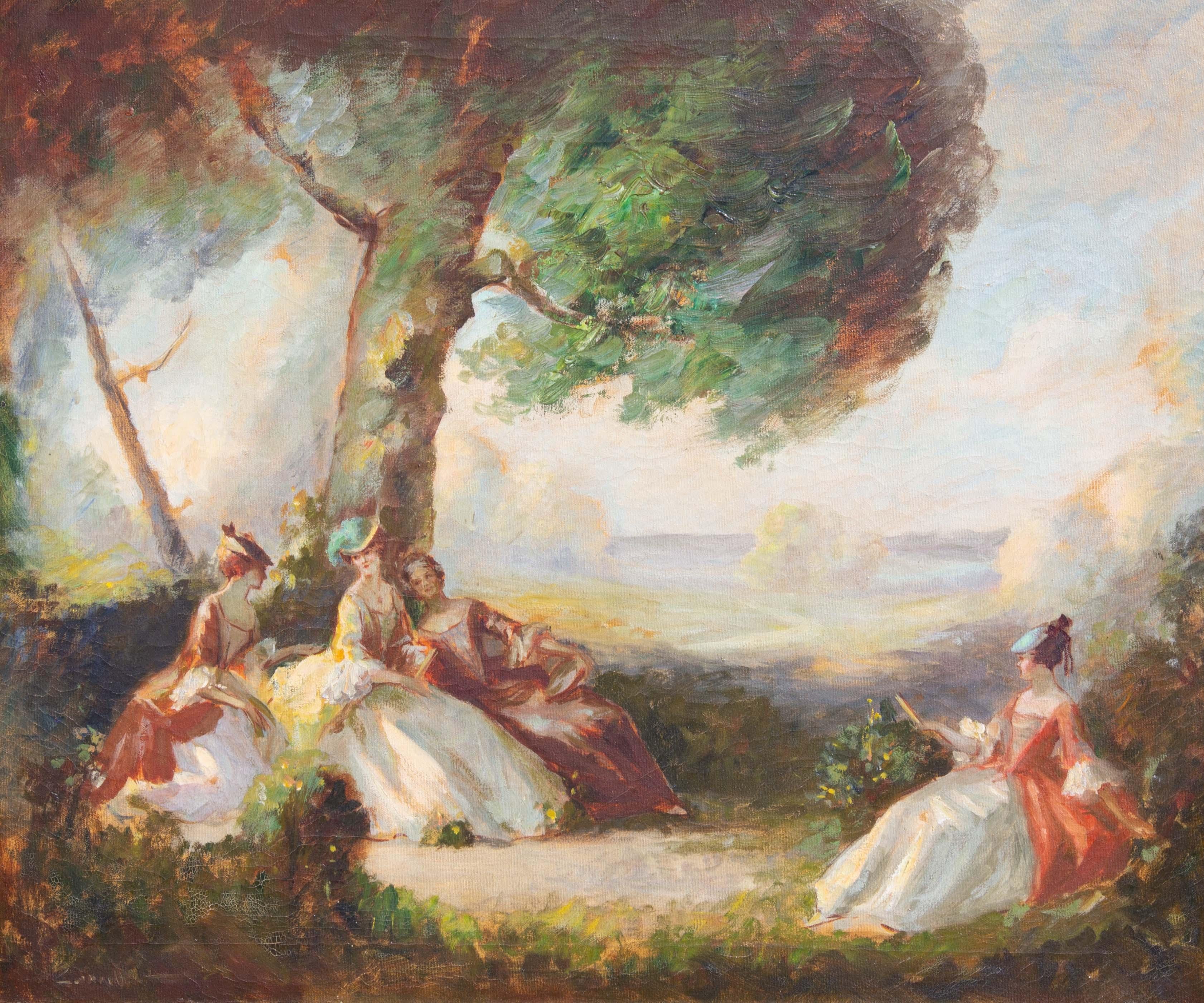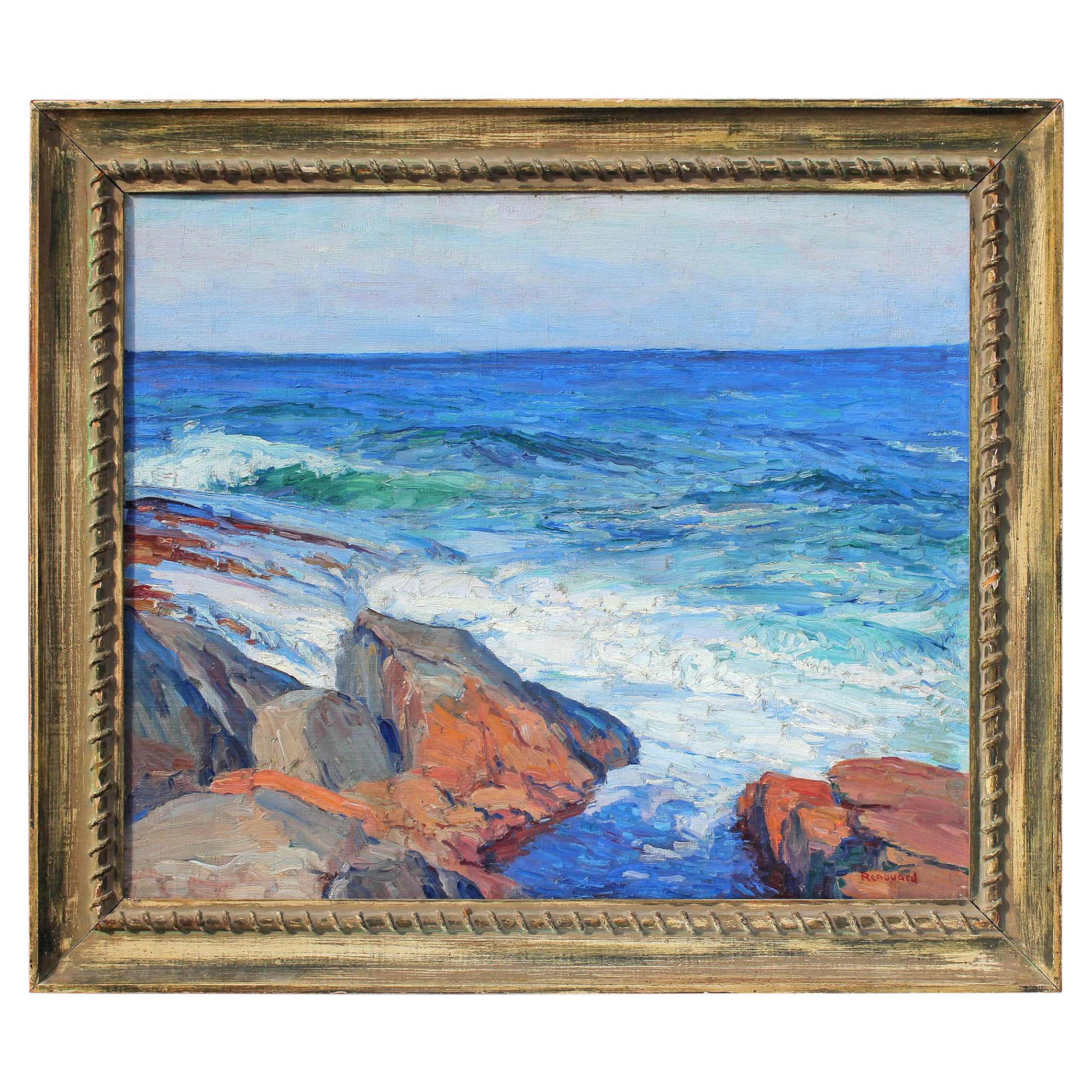Items Similar to "St Ives From the Quay Cornwall England"
Want more images or videos?
Request additional images or videos from the seller
1 of 6
Hayley Lever"St Ives From the Quay Cornwall England"1904
1904
About the Item
Jim's of Lambertville is proud to offer this artwork by Hayley Lever (1875 – 1958)
Born in Adelaide, Australia in 1875, Richard Hayley Lever was best known for his paintings that synthesized the vivid colors of impressionism with the strong lines of realism. He experimented with numerous styles of impressionism throughout his career.
Lever showed maturity in his artistic skill at an early age, traveling to England in 1893 to study in London. It was during his time working at an artists’ colony in Cornwall, on the coast of St. Ives, that he became enamored by the coastal landscape, which would become a lifelong subject of his works.
Lever came to America in 1911, quickly becoming one of the most widely exhibited artists in New York City. Many of the scenes he painted at this time were of Manhattan. He also had a summer studio in Gloucester, Massachusetts. From 1919 to 1931, Lever taught at the Art Students League in New York City and became the Director of the Studio Art Club in Mount Vernon, New York.
Lever received numerous awards and critical acclaim throughout his lifetime and his works were purchased by major American museums, such as New York's Metropolitan Museum of Art and Washington's Phillips Collection and Corcoran Museum.
- Creator:Hayley Lever (1876-1958, American)
- Creation Year:1904
- Dimensions:Height: 18 in (45.72 cm)Width: 22 in (55.88 cm)Depth: 3 in (7.62 cm)
- Medium:
- Movement & Style:
- Period:
- Condition:
- Gallery Location:Lambertville, NJ
- Reference Number:
About the Seller
5.0
Vetted Seller
These experienced sellers undergo a comprehensive evaluation by our team of in-house experts.
Established in 1997
1stDibs seller since 2014
36 sales on 1stDibs
Typical response time: 6 hours
- ShippingRetrieving quote...Ships From: Lambertville, NJ
- Return PolicyThis item cannot be returned.
More From This SellerView All
- "Forest Strongholds"By John F. CarlsonLocated in Lambertville, NJSigned lower right. Complemented by a hand carved and gilt frame. Exhibited at the National Academy of Design, 1928Category
20th Century American Impressionist Landscape Paintings
MaterialsCanvas, Oil
- "Welldiggers from Titusville"By Mary Elizabeth PriceLocated in Lambertville, NJJim’s of Lambertville is proud to offer this artwork. Signed lower right. Complemented by a hand carved and gilt frame. Illustrated in "New Hope for American Art" by James Alterman, and "Blue Chips" published by Jim's of Lambertville. M. Elizabeth Price (1877 - 1965) Mary Elizabeth Price was born in West Virginia and raised on a farm in Solebury, Pennsylvania, on the outskirts of New Hope. She studied at the Pennsylvania School of Industrial Arts and the Pennsylvania Academy of the Fine Arts under Hugh Breckenridge. Additionally, she studied in New Hope with William Lathrop. Following her art studies, Price went to New York. While there, she conducted the “Baby Art...Category
1920s American Impressionist Landscape Paintings
MaterialsCanvas, Oil
- "Beached"By John R. GrabachLocated in Lambertville, NJJim’s of Lambertville is proud to offer this artwork by: John R. Grabach (1886 - 1981) John Grabach was a highly regarded New Jersey artist, teacher, and author of the classic text...Category
1930s American Impressionist Landscape Paintings
MaterialsCanvas, Oil
- "River Party"By Joseph BarrettLocated in Lambertville, NJIllustrated in "Joseph Barrett, The Prime Years 1970s - 1990s", pg. 32, plate #036. Jim’s of Lambertville is proud to offer this artwork by: Joseph Barrett (1936 – ) Joseph B...Category
Late 20th Century American Impressionist Landscape Paintings
MaterialsCanvas, Oil
- "In Port"By Edward Willis RedfieldLocated in Lambertville, NJJim’s of Lambertville is proud to offer this artwork by: Edward Willis Redfield (1869 - 1965) Edward W. Redfield was born in Bridgeville, Delaware, moving to Philadelphia as a young child. Determined to be an artist from an early age, he studied at the Spring Garden Institute and the Franklin Institute before entering the Pennsylvania Academy from 1887 to 1889, where he studied under Thomas Anshutz, James Kelly, and Thomas Hovenden. Along with his friend and fellow artist, Robert Henri, he traveled abroad in 1889 and studied at the Academie Julian in Paris under William Bouguereau and Tony Robert-Fleury. While in France, Redfield met Elise Deligant, the daughter of an innkeeper, and married in London in 1893. Upon his return to the United States, Redfield and his wife settled in Glenside, Pennsylvania. He remained there until 1898, at which time he moved his family to Center Bridge, a town several miles north of New Hope along the Delaware River. Redfield painted prolifically in the 1890s but it was not until the beginning of the twentieth century that he would develop the bold impressionist style that defined his career. As Redfield’s international reputation spread, many young artists gravitated to New Hope as he was a great inspiration and an iconic role model. Edward Redfield remained in Center Bridge throughout his long life, fathering his six children there. Around 1905 and 1906, Redfield’s style was coming into its own, employing thick vigorous brush strokes tightly woven and layered with a multitude of colors. These large plein-air canvases define the essence of Pennsylvania Impressionism. By 1907, Redfield had perfected his craft and, from this point forward, was creating some of his finest work. Redfield would once again return to France where he painted a small but important body of work between 1907 and 1908. While there, he received an Honorable Mention from the Paris Salon for one of these canvases. In 1910 he was awarded a Gold Medal at the prestigious Buenos Aires Exposition and at the Panama-Pacific Exposition of 1915 in San Francisco, an entire gallery was dedicated for twenty-one of his paintings. Since Redfield painted for Exhibition with the intent to win medals, his best effort often went into his larger paintings. Although he also painted many fine smaller pictures, virtually all of his works were of major award-winning canvas sizes of 38x50 or 50x56 inches. If one were to assign a period of Redfield’s work that was representative of his “best period”, it would have to be from 1907 to 1925. Although he was capable of creating masterpieces though the late 1940s, his style fully matured by 1907 and most work from then through the early twenties was of consistently high quality. In the later 1920s and through the 1930s and 1940s, he was like most other great artists, creating some paintings that were superb examples and others that were of more ordinary quality. Redfield earned an international reputation at a young age, known for accurately recording nature with his canvases and painting virtually all of his work outdoors; Redfield was one of a rare breed. He was regarded as the pioneer of impressionist winter landscape painting in America, having few if any equals. Redfield spent summers in Maine, first at Boothbay Harbor and beginning in the 1920s, on Monhegan Island. There he painted colorful marine and coastal scenes as well as the island’s landscape and fishing shacks. He remained active painting and making Windsor style furniture...Category
Early 1900s American Impressionist Landscape Paintings
MaterialsCanvas, Oil
- “Evening in Newark”By John R. GrabachLocated in Lambertville, NJIllustrated in "New Hope for American Art", pg. 194. Jim’s of Lambertville is proud to offer this artwork by: John R. Grabach (1886 - 1981) John Grabach was a highly regarded New ...Category
20th Century American Impressionist Landscape Paintings
MaterialsCanvas, Oil
You May Also Like
- Venice Landscape Italian Oil on Canvas Painting in Gilt Wood Frame, Belle EpoqueLocated in Firenze, ITThis delightful turn of the century (early 20th century) oil on canvas painting represents an Italian landscape with one of the most famous squares in the world: Piazza San Marco in ...Category
Early 20th Century Impressionist Landscape Paintings
MaterialsCanvas, Oil
- Houses And River-Large Impressionist Landscape Oil on Canvas Signed A.HuntingtonLocated in Coimbra, PT"Houses And River" Signed A. Huntington (English School) Oil on canvas Measures: Canvas - 60x110 cm (Gilt Wood Frame - 76x126 cm) Private collection. FramedCategory
Early 20th Century Impressionist Landscape Paintings
MaterialsCanvas, Oil
- Temple of Paestum, Max Usadel (ca. 1880-1950), 1912, Oil Paint on CanvasLocated in Greding, DEMax Usadel (ca.1880-1950), Temple of Paestum, dat. 1912 View of the temple of Paestum with two ox carts in the foreground. The setting sun creates a dramati...Category
1910s Impressionist Landscape Paintings
MaterialsCanvas, Oil
- Impressionist Seascape Oil Painting by George RenouardBy George RenouardLocated in Rochester, NYImpressionist American seascape, oil painting by George Renouard. Inscribed on reverse "1st Chapter-Genesis by Renouard". Oil on canvas. Signed lower...Category
Early 20th Century Impressionist Landscape Paintings
MaterialsCanvas, Oil
- French Impressionist Garden Scene PaintingLocated in Rochester, NYFrench impressionist style painting. Oil on canvas. Signed illegibly. In the original frame.Category
Early 20th Century Impressionist Figurative Paintings
MaterialsOil, Canvas
- Romantic French Shepherdess 19th Century Landscape Painting by Jean BeauduinBy Jean BeauduinLocated in Rochester, NYFrench shepherdess at twilight by Jean Beauduin (1851-1916). Oil on canvas mounted on board. Original Barbizon frame. I believe the dog is a bergere Pic...Category
19th Century Impressionist Landscape Paintings
MaterialsCanvas, Oil, Panel
Recently Viewed
View AllMore Ways To Browse
Travel England
Antique Lever
Antique Colony
St Ives Artists
Oil Landscape Cornwall
Antique Art Australia
Gloucester Artists
New England Coastal Art
New England Coastal
Gloucester Massachusetts
Coastal New England Paintings
Antique Cornwall
Paintings Of Gloucester Massachusetts
Scenes Of Cornwall
Australia Coast Painting
Antique Paintings Australia
Richard Phillips
Antique Gloucester





